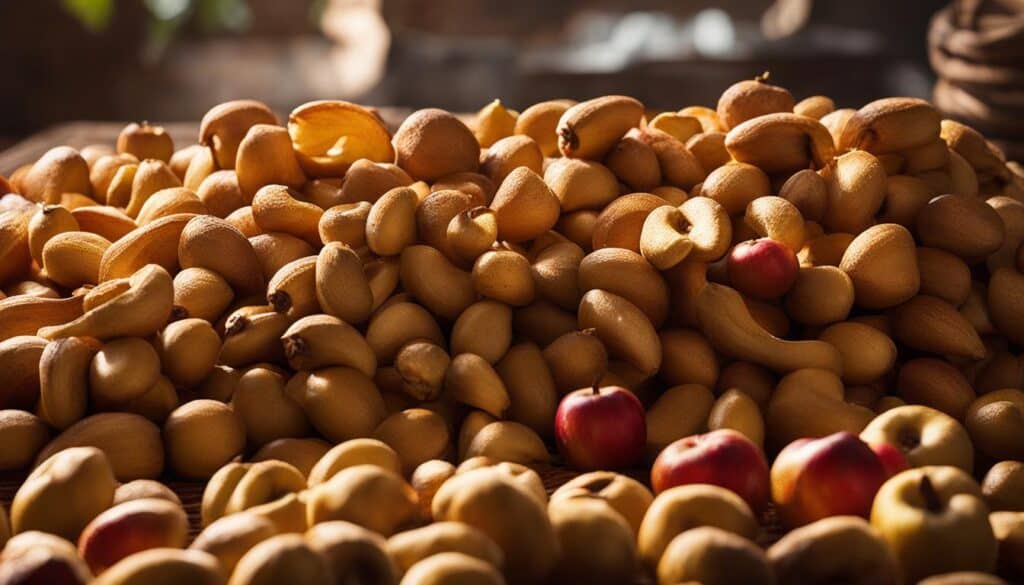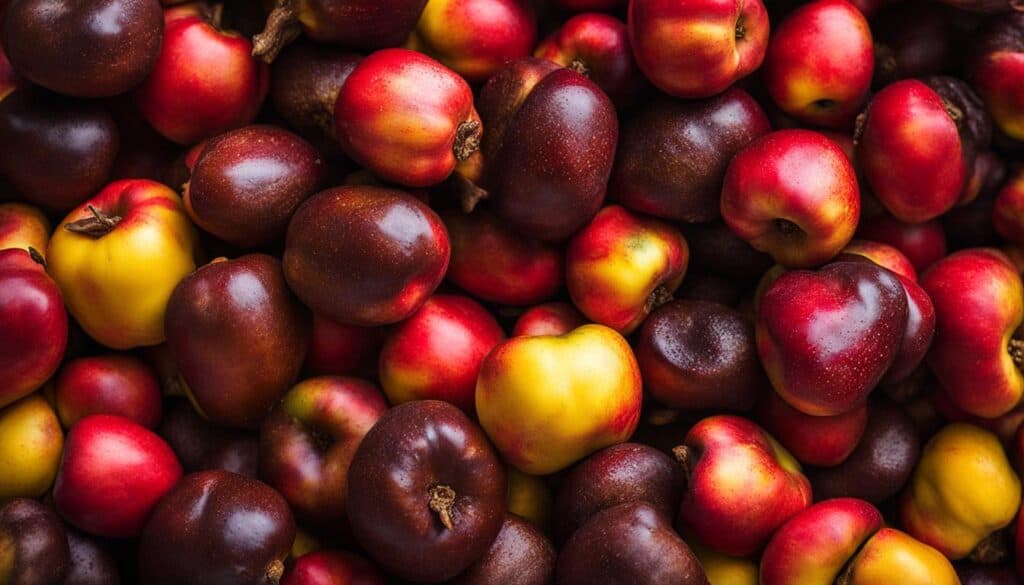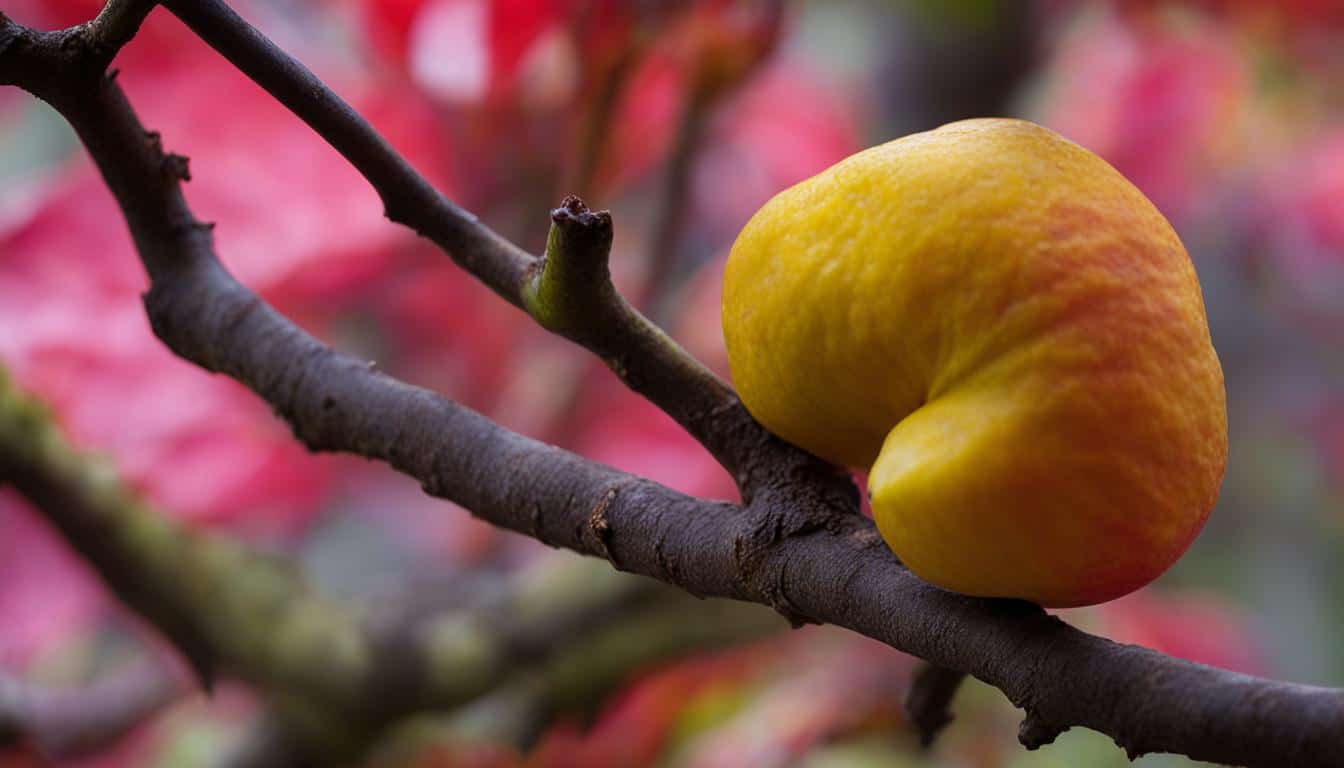Greetings, food enthusiasts! Today, I will be delving into the topic that has left many curious minds puzzled – the edibility of cashew fruit. We all know and love cashew nuts, but what about the fruit itself? Is it safe to consume? In this article, I will provide you with all the information you need to satisfy your curiosity about cashew fruit. So, let’s dive right in!
But before we get started, take a moment to feast your eyes on this tantalizing image of a ripe cashew fruit. Isn’t it a true beauty? Now, let’s find out if it’s not just visually appealing but also edible.
Key Takeaways:
- Cashew fruit is a commonly questioned edible fruit associated with cashew nuts.
- Cashew fruit is rich in nutrients, including high vitamin C content and antioxidants.
- It is used in various culinary applications, from fresh consumption to jams, juices, and more.
- Preservation methods like juicing, freezing, drying, and canning extend its shelf life.
- While cashew nuts can be allergenic, properly roasted nuts are safe for consumption.
Nutritional Value of Cashew Fruit
Cashew fruit is not just delicious but also packed with essential nutrients that can benefit your health. Let’s explore the nutritional value of this tropical fruit and discover why it deserves a place in your diet.
Vitamin C: Cashew fruit is a rich source of vitamin C, with 200-269 mg per 100ml, which is significantly higher than orange juice. Vitamin C is an antioxidant that helps protect cells from damage, supports the immune system, and promotes collagen production for healthy skin and joints.
Antioxidants and Phenolic Compounds: Cashew fruit contains antioxidants and phenolic compounds, which have been linked to various health benefits. These compounds help reduce inflammation, fight oxidative stress, and may even have anticancer properties.
Protein and Dietary Fiber: While cashew fruit is not as protein-rich as cashew nuts, it still contains moderate levels of protein. Additionally, it provides dietary fiber, which aids in digestion, promotes feelings of fullness, and helps maintain healthy blood sugar levels.
| Nutrient | Amount per 100g |
|---|---|
| Vitamin C | 200-269 mg |
| Protein | 0.6 g |
| Dietary Fiber | 0.9 g |
Include cashew fruit in your diet to reap its nutritional benefits and add a tropical twist to your meals. Whether you enjoy it fresh, juiced, or incorporated into various recipes, cashew fruit can be a delightful and nutritious addition to your culinary repertoire.
The Nutritional Value of Cashew Fruit at a Glance
- High in vitamin C, which supports the immune system and promotes healthy skin.
- Rich in antioxidants and phenolic compounds, which help fight inflammation and oxidative stress.
- Contains moderate levels of protein and dietary fiber for digestion and satiety.
“Cashew fruit is not only delicious but also a nutritional powerhouse. With its high vitamin C content, antioxidants, and fiber, it can provide numerous health benefits. Don’t overlook this tropical gem and explore the various ways to incorporate cashew fruit into your diet.”
Culinary Uses of Cashew Fruit
Cashew fruit is a versatile ingredient that finds its place in various culinary applications. Its unique combination of flavors, combining the tartness of lime and orange with the sweetness of mango, makes it a delightful addition to both sweet and savory dishes.
In some regions, cashew fruit is enjoyed fresh, either on its own or as an addition to fruit salads and smoothies. Its juicy and refreshing character adds a burst of tropical goodness to these dishes.
Another popular way to utilize cashew fruit is by transforming it into juices, jams, and wines. The vibrant color and distinct taste of the fruit lend themselves perfectly to these preparations. Whether sipped as a refreshing beverage or spread on toast, cashew fruit-based products offer a unique and flavorful experience.
Processing and Preservation of Cashew Fruit

Cashew fruit has a short shelf life due to its high perishability. To extend its usability and enjoy its flavors and nutritional benefits for longer periods, various processing and preservation methods are employed. These methods include juicing, freezing, drying, and canning.
Juicing is a popular method to preserve the fruit’s flavor and nutritional value. Cashew fruit juice can be pasteurized and bottled for a longer shelf life, allowing consumers to enjoy its refreshing taste even when the fruit is out of season. Freezing and drying methods are employed to preserve the fruit for later use in culinary applications. These methods retain the fruit’s essence and make it convenient to incorporate into various recipes. Canned products, such as jams and preserves, offer a convenient way to enjoy cashew fruit throughout the year, as they have a longer shelf life and can be easily stored.
By utilizing these processing and preservation methods, we can make the most of cashew fruit, ensuring minimal wastage and maximizing its culinary potential. Whether it’s enjoying a glass of cashew fruit juice, adding dried cashew fruit to baked goods, or spreading cashew fruit jam on toast, these preservation techniques allow us to savor the unique flavors and nutritional benefits of cashew fruit all year round.
Table: Comparison of Cashew Fruit Preservation Methods
| Preservation Method | Advantages | Disadvantages |
|---|---|---|
| Juicing | – Preserves the flavor and nutritional value of the fruit – Pasteurized juice can be bottled for a longer shelf life | – Requires specialized equipment for juicing and pasteurization |
| Freezing | – Preserves the fruit’s texture and taste – Allows for easy incorporation into recipes | – Requires freezer storage space – May cause slight changes in texture after thawing |
| Drying | – Extends the shelf life of the fruit – Can be easily stored and used in various recipes | – May result in slight changes in flavor and texture |
| Canning | – Offers long shelf life – Convenient for storage and use | – may involve added preservatives or sweeteners in canned products |
The Toxicity of Cashew Fruit
Cashew fruit is generally safe to consume, but it’s important to be aware of the potential toxicity associated with the fruit’s nuts. The cashew nut is surrounded by a double shell that contains an allergenic phenolic resin called anacardic acid. This resin can cause skin irritation and allergic reactions in some individuals. To ensure safety, it’s crucial to roast the cashew nuts before consumption, as roasting deactivates the toxin in the shells.
As long as the nuts are properly roasted, cashew fruit is considered safe and edible. The majority of commercial cashew nuts undergo a roasting process, making them safe for consumption. However, it’s important to be cautious when handling raw cashew nuts or homemade cashew nut products.
It’s worth noting that cashew fruit itself does not contain the toxic resin. The resin is primarily found in the outer shells of the nuts. If you’re unsure whether the cashew nuts you have are roasted or raw, it’s best to consult the packaging or purchase roasted nuts from reputable sources.
Table: Potential Cashew Fruit Toxicity Symptoms
| Symptoms | Severity |
|---|---|
| Skin irritation and rash | Mild to moderate |
| Hives | Moderate |
| Swelling of the face, lips, or tongue | Moderate to severe |
| Difficulty breathing | Severe |
| Anaphylaxis | Life-threatening |
If you experience any of these symptoms after consuming cashew nuts, it’s important to seek medical attention immediately. Anaphylaxis, a severe allergic reaction, requires immediate emergency medical treatment.
Overall, with proper roasting and cautious consumption, cashew fruit can be enjoyed safely as part of a balanced diet. It’s essential to be aware of any allergies or sensitivities you may have and take necessary precautions to avoid potential adverse reactions.
Cashew Nut Production and Economic Importance

Cashew nuts are a significant agricultural product with a thriving global market. India, Côte d’Ivoire, and Vietnam are the largest cashew nut producers, contributing to the majority of the world’s production. In Tanzania, the regions of Mtwara, Lindi, Ruvuma, and Pwani play a crucial role in cashew nut production, accounting for over 80% of the country’s total output.
The cashew nut industry in Tanzania has immense economic importance, generating millions of dollars in export revenue. It also provides employment opportunities for numerous small-scale farmers, contributing to rural development and poverty reduction in these cashew-producing regions.
The cultivation and processing of cashew nuts involve various steps. After harvest, the cashew apples are removed, and the nuts are extracted from their shells. The nuts undergo a process of sun drying to reduce moisture content before being sorted, graded, and packaged for sale. These cashew nuts are then exported to different countries, where they are used in the food industry, as snacks, or for further processing into cashew butter, oils, and other value-added products.
Table: Top Cashew Nut Producing Countries
| Rank | Country | Production (metric tons) |
|---|---|---|
| 1 | India | 653,000 |
| 2 | Côte d’Ivoire | 572,000 |
| 3 | Vietnam | 374,460 |
| 4 | Nigeria | 260,000 |
| 5 | Tanzania | 223,000 |
Source: International Nut and Dried Fruit Council (INC), 2021
As the demand for cashew nuts continues to grow worldwide, the cashew nut industry plays a vital role in supporting livelihoods, driving economic growth, and boosting international trade. It serves as a valuable source of revenue for cashew-producing countries, contributing to their overall development and prosperity.
Underutilization of Cashew Apples
Cashew apples, the fleshy part of the cashew fruit, are often overlooked and underutilized. Despite their potential as a valuable resource, they are typically consumed as a field snack during cashew nut harvesting and are not widely marketed or processed. This underutilization is mainly due to the fruit’s high perishability, astringent taste, and lack of awareness regarding its potential uses.
Table: Cashew Apple Utilization
| Challenges | Opportunities |
|---|---|
| High perishability | Development of processing and preservation technologies |
| Lack of knowledge on nutritional value and culinary uses | Increased awareness and education |
| Limited distribution and marketing networks | Investments in infrastructure and efficient networks |
| Insufficient value-added product development | Creation of employment opportunities and entrepreneurship |
“Cashew apples have immense potential for various applications, from juices and jams to wines and value-added products. Their unique flavor and nutritional profile make them a valuable ingredient in the culinary world. However, unlocking the full potential of cashew apples requires addressing the challenges they face and seizing the opportunities that lie ahead.”
H3: Economic and Environmental Impact
The underutilization of cashew apples not only results in missed opportunities for food and nutrition security but also has economic and environmental implications. Large quantities of cashew apple pulp go to waste, leading to economic losses and environmental degradation. Implementing efficient utilization methods can mitigate these negative impacts and contribute to sustainable socio-economic development.
Potential Benefits of Cashew Apple Utilization

When it comes to cashew fruit, the focus is often on the nuts. However, there is untapped potential in utilizing the cashew apples to create value-added products. The utilization of cashew apples can bring forth a range of benefits, including reducing postharvest losses, increasing food and nutrition security, and contributing to sustainable economic growth.
By processing cashew apples into juices, jams, and wines, we can create new opportunities for employment, especially for women and young people in rural areas. These value-added products not only showcase the unique flavors of cashew fruit but also provide a way to extend its shelf life and make it accessible throughout the year. Additionally, the utilization of cashew apples can diversify the cashew industry, promote trade, and enhance the overall socio-economic well-being of communities.
“The utilization of cashew apples is not just about creating delicious products; it is about transforming lives and communities.”
Unlocking the Potential
To fully harness the benefits of cashew apple utilization, there are challenges that need to be addressed. Firstly, the high perishability of the fruit poses a significant hurdle. Investment in infrastructure, such as cold storage facilities and transportation networks, is essential to ensure that cashew apples reach the market in optimal condition. Additionally, support for small-scale farmers in adopting proper harvesting and processing techniques is crucial.
Furthermore, creating awareness about the nutritional value and culinary uses of cashew apples is essential to drive demand. It is important to educate consumers about the various ways they can enjoy cashew apple products and to showcase the versatility of this underutilized fruit. Through targeted marketing campaigns and partnerships with local communities, we can unlock the full potential of cashew apples and promote their utilization on a larger scale.
| Benefits of Cashew Apple Utilization | Potential Impact |
|---|---|
| Reduction of postharvest losses | Increase in income and food availability |
| Creation of employment opportunities | Socio-economic transformation in rural areas |
| Diversification of the cashew industry | Promotion of trade and economic growth |
| Enhancement of food and nutrition security | Improved health outcomes |
The potential benefits of cashew apple utilization are vast. By focusing on overcoming challenges, promoting awareness, and creating a supportive ecosystem, we can unlock the socio-economic transformation that lies within cashew fruit. It is time to embrace the edible nature of cashew apples and harness their benefits for a healthier and more sustainable future.
Challenges and Opportunities for Cashew Apple Utilization

Cashew apple utilization presents both challenges and opportunities for the cashew industry. While cashew apples have immense potential, several obstacles need to be overcome to fully capitalize on their benefits. One of the main challenges is the fruit’s high perishability, which limits its shelf life and requires efficient processing and preservation methods. Additionally, there is a lack of awareness regarding the nutritional value and culinary uses of cashew apples, hindering their marketability.
Challenges of Cashew Apple Utilization
- Perishability: Cashew apples have a short shelf life due to their delicate nature, making it crucial to develop effective preservation techniques to prevent spoilage and postharvest losses.
- Processing and Preservation Technologies: The absence of suitable processing and preservation technologies poses a significant challenge in maximizing the utilization of cashew apples.
- Low Awareness: Limited knowledge about the nutritional value, flavor profile, and potential culinary uses of cashew apples contributes to their underutilization.
Overcoming these challenges requires strategic interventions, investments in infrastructure, and targeted capacity-building programs to empower small-scale farmers and processors. By addressing these obstacles, the cashew industry can unlock the full potential of cashew apples and leverage their economic, nutritional, and culinary benefits.
Opportunities for Cashew Apple Utilization
- Value Addition: Processing cashew apples into value-added products such as juices, jams, and wines can open up new markets and create additional revenue streams.
- Employment Opportunities: Cashew apple utilization can generate employment opportunities, particularly for women and young people in rural areas, through the establishment of processing units and value chain development.
- Diversification: The inclusion of cashew apples in the cashew industry can diversify product offerings, leading to increased market competitiveness and trade opportunities.
Maximizing the opportunities associated with cashew apple utilization requires collaboration among stakeholders, including governments, research institutions, farmers, processors, and traders. By harnessing the potential of cashew apples, we can drive socio-economic transformation, enhance food security, and create a more sustainable and inclusive cashew industry.
Conclusion
In conclusion, the cashew fruit is indeed edible. While most people are familiar with the cashew nut, the fruit itself offers a range of unique flavors, nutritional value, and culinary versatility. Not only is it rich in nutrients like vitamin C, antioxidants, and dietary fiber, but it also has a delightful flavor profile that combines tartness and sweetness.
Through various processing and preservation methods such as juicing, freezing, drying, and canning, the perishability of cashew fruit can be overcome, allowing its usability to be extended. These methods not only help preserve the fruit’s flavor and nutrients but also offer convenient ways to enjoy cashew fruit throughout the year.
While cashew fruit is generally safe to consume, it is important to note the potential allergenicity of the cashew nut, which is part of the fruit. Roasting the cashew nuts before consumption can deactivate the allergenic phenolic resin present in the shells, ensuring their safety.
By addressing challenges such as perishability, lack of awareness, and limited processing technologies, we can fully unleash the potential of cashew apples. This can lead to the development of value-added products, increased food and nutrition security, and sustainable economic growth. Let’s embrace the edible nature of cashew fruit and harness its benefits for a healthier and more sustainable future.
FAQ
Is cashew fruit edible?
Yes, cashew fruit is edible.
What are the nutritional values of cashew fruit?
Cashew fruit is a rich source of vitamin C, antioxidants, amino acids, sugar, phenolic compounds, protein, and dietary fiber.
How is cashew fruit used in cuisine?
Cashew fruit can be consumed fresh, added to fruit salads and smoothies, used to make juices, jams, wines, desserts, sauces, and marinades.
How can cashew fruit be processed and preserved?
Cashew fruit can be juiced, frozen, dried, or canned to extend its shelf life.
Is cashew fruit toxic?
Cashew fruit is safe to consume, but the cashew nut within the fruit is surrounded by a double shell containing an allergenic phenolic resin called anacardic acid. Roasting the nuts before consumption deactivates the toxin.
What is the economic importance of cashew nut production?
Cashew nuts are the primary harvest and driver of cashew tree cultivation, generating significant export revenue and employment opportunities in countries like India, Côte d’Ivoire, Vietnam, and Tanzania.
Why are cashew apples underutilized?
Cashew apples are often underutilized due to their high perishability, astringent taste, and lack of awareness about their potential uses.
What are the potential benefits of cashew apple utilization?
Utilizing cashew apples can reduce postharvest losses, increase food and nutrition security, create employment opportunities, diversify the cashew industry, promote trade, and enhance socio-economic well-being.
What challenges and opportunities are associated with cashew apple utilization?
Challenges include high perishability, lack of processing and preservation technologies, and insufficient awareness. Opportunities include investments in infrastructure, support for small-scale farmers, and the establishment of efficient distribution and marketing networks.
Source Links
- http://www.foodandnutritionjournal.org/volume11number2/underutilized-cashew-apple-fruit-its-utility-and-development-as-a-source-of-nutrients-and-value-added-products-in-tanzania/
- https://www.ncbi.nlm.nih.gov/pmc/articles/PMC9578815/
- https://matthewcevans.com/2010/08/11/youve-got-to-be-nuts-to-eat-a-cashew-nut-shell/





Leave a Reply